In this article:
- Hybrid engines leak test: a matter of life and death
- Hybrid engine testing: Lamborghini chooses the reliability of Movingfluid
- The control phases. Step by step, the certainty of a perfect seal
- Our mishap solvers have numbers
Hybrid engines leak test: a matter of life and death
The new hybrid engines impose a series of stringent additional leak tests compared to conventional endothermic engines, to which Movingfluid has given a concrete response with the realisation of a complete Leak Test system for hybrid engines.
In the automotive industry, the leak test is that essential stage on the outcome of which depends the life or death of an engine. If the components are assembled correctly and the materials are faultless, the leak test will be positive: no leaks detected. The engine lives on.
But if the leak test detects the unwanted passage of liquids or gases through what should be an airtight seal, then the engine will be destined to stop running immediately and not continue on its way to the road.
Movingfluid‘s new Leak Test system for hybrid engines is able to check the tightness of all new-generation components, such as inverters or plate heat exchangers, in addition to the basic constituent components of the endothermic engine, i.e. the engine block, intake manifolds and cylinder heads.
A reliable and modular control, applicable to every construction phase, capable of eliminating the possibility of the disastrous scenarios resulting from the identification of a faulty engine at the end of the production process, with liquid or gas leaks.
A leakage detection in the final phase would in fact imply going back to the processes, with further investment in terms of time and costs. But above all, in this case, the need would arise to identify precisely the reason for an unfavourable outcome. Everything can be questioned, in search of a corrective action.
On the other hand, the risks involved in putting a defective vehicle on the road are immeasurable. At risk are first and foremost the safety of people, but also the reliability and credibility of the brand. Last but not least, this would entail very high repair costs if the vehicle reveals the defect within the warranty period or for proven factory defects.
If confidence in your brand collapses, you can kiss your market goodbye.
This is why Lamborghini chose to entrust us with the installation of a complete Leak Test system that would reliably and accurately complete its production lines dedicated to the manufacture of hybrid engines, perfectly integrated with the existing systems. This concerns both the positioning of the additional machinery and the ability of the additional software to interface and dialogue with the MES already in use at the company.
Hybrid engine testing: Lamborghini chooses the reliability of Movingfluid
We have long had the honour of being at Lamborghini‘s side on a path of quality that touches different production areas, with a trust that is renewed time after time in our team of mishap-solvers and results that always go one step beyond expectations.
We have already spoken in this Journal about our support in the realisation of customised spray booths, with visual alignment to existing installations and significantly improved performance compared to existing equipment in terms of suction capacity and air recirculation.
From our support in the painting phase, an activity in which achieving a high aesthetic level is one of the essential objectives to attract and make a potential customer fall in love with us, we move in this case history to focus on the heart of the vehicle: its engine. A heart that – in and out of metaphor – must prove reliable over time and know how to move those who make the choice to ‘marry’ Lamborghini.
One of the essential tests the engine must undergo to be considered reliable and suitable for installation in the vehicle is the Leak Test. We have long stood by Lamborghini with this control applied to endothermic engines. An articulated experience, which has gradually led us to achieve excellence and to refine a complete Leak Test system, capable of testing every stage of construction, also applicable to the new hybrid engines.
The unique prerogative of this innovative leak test method is precisely the possibility of testing at every stage of manufacture, from pre-assembly to filling the circuit. This allows the precise and timely detection of any faults before proceeding to the next stage, containing the possible reverberation of the error compared to other engines or over time.
If you haven’t already done so, we invite you to learn more about all the advantages of the complete Leak Test system developed by Movingfluid in our article Complete Leak Test System for Hybrid Engines and Endothermic Engines.
Because here, now, we are about to see it in detail in one of its most representative applications, i.e. with the implementation in succession of all the control phases.
We talk about Lamborghini, in this example, but we could talk about any other manufacturer in the automotive industry. From the most renowned brand to contractors, the reliability of an engine must be the same, and that is total, for everyone.
This is why the Leak Test system developed by Movingfluid is versatile and customisable, responding to different functions that can be freely chosen by the client according to his specific requirements.
Here we analyse them all. Feel free to choose your own.
Do you want a demonstration on one of your engines?
The control phases. Step by step, the certainty of a perfect seal
Below, we see in detail all the phases of the Leak Test system devised by Movingfluid applied in sequence to a Lamborghini 12-cylinder hybrid engine to check its tightness.
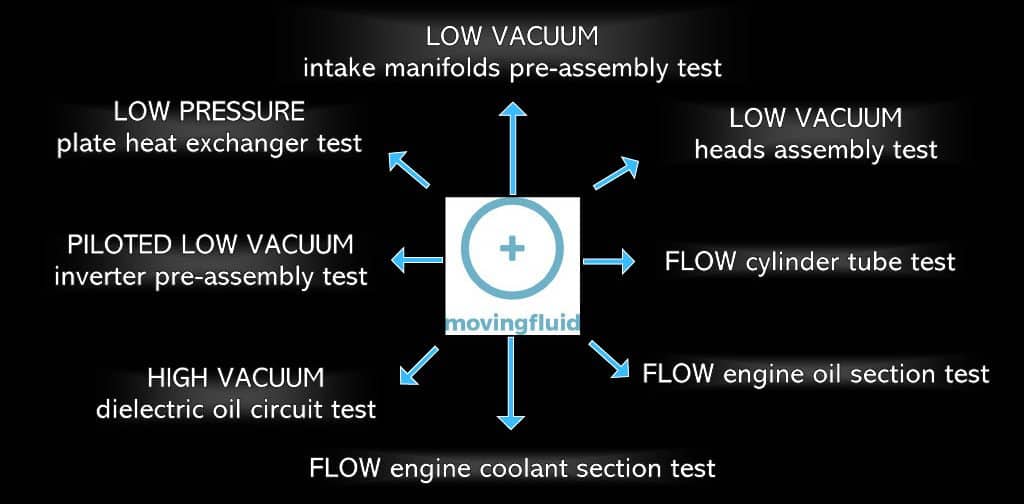
Phase 1: Hybrid engine pre-assembly test
In order to test whether the pre-assembly phase was performed correctly, the following applied tests were carried out:
- LOW VACUUM intake manifolds pre-assembly test
- FLOW VACUUM cylinder heads pre-assembly test
Test performance:
- the 12 manifolds were tested simultaneously but independently
- vacuum was generated in each individual manifold to approximately 300 mbar absolute via a Venturi unit feeding a manifold of 12 solenoid valves, one for each manifold
- on the same manifold, the solenoid valves have been configured in such a way that both vacuum and compressed air can be switched on each manifold. In the event of a test failure, this would have allowed the individual manifold to be ‘located’ so that the operator could find the leak and proceed to rework
- a miniaturised pressure sensor (1 cm3) with a dual scale -1bar<>+1bar was inserted on each individual test line between the manifold and engine
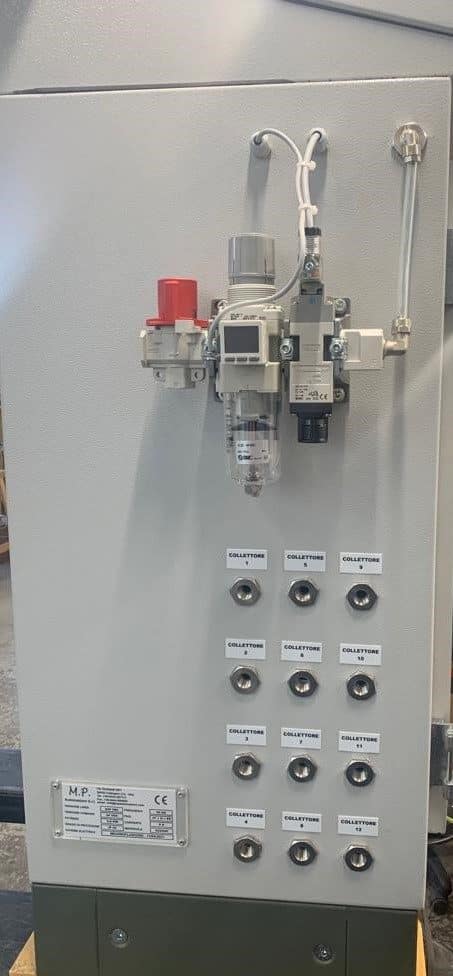
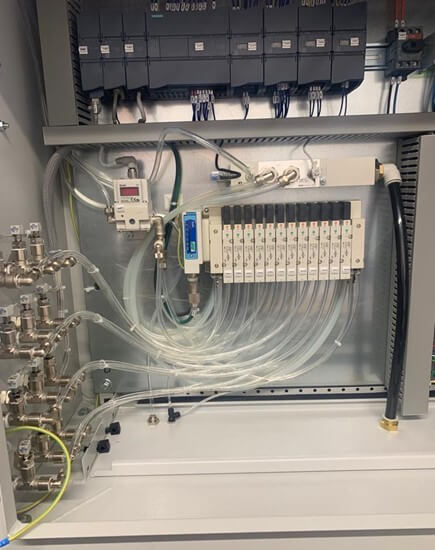
Phase 2: cylinder liners test, engine oil section, hybrid engine coolant section
To test whether the assembly phase of the liners was performed correctly, the following applied tests were carried out:
- FLOW cylinder liner test
- FLOW engine oil section test
- FLOW engine coolant section test
Test performance:
- the affected area was unique and comprised 12 cylinder liners
- the flow test involves pressurising a working tank to a specific pressure
- the communication between the tank and the engine was opened
- this led to a target levelling of the static test pressure
- pressure-stabilised, a flow sensor capable of detecting movements in the order of a hundredth of a cubic centimetre per minute was then automatically inserted into the line
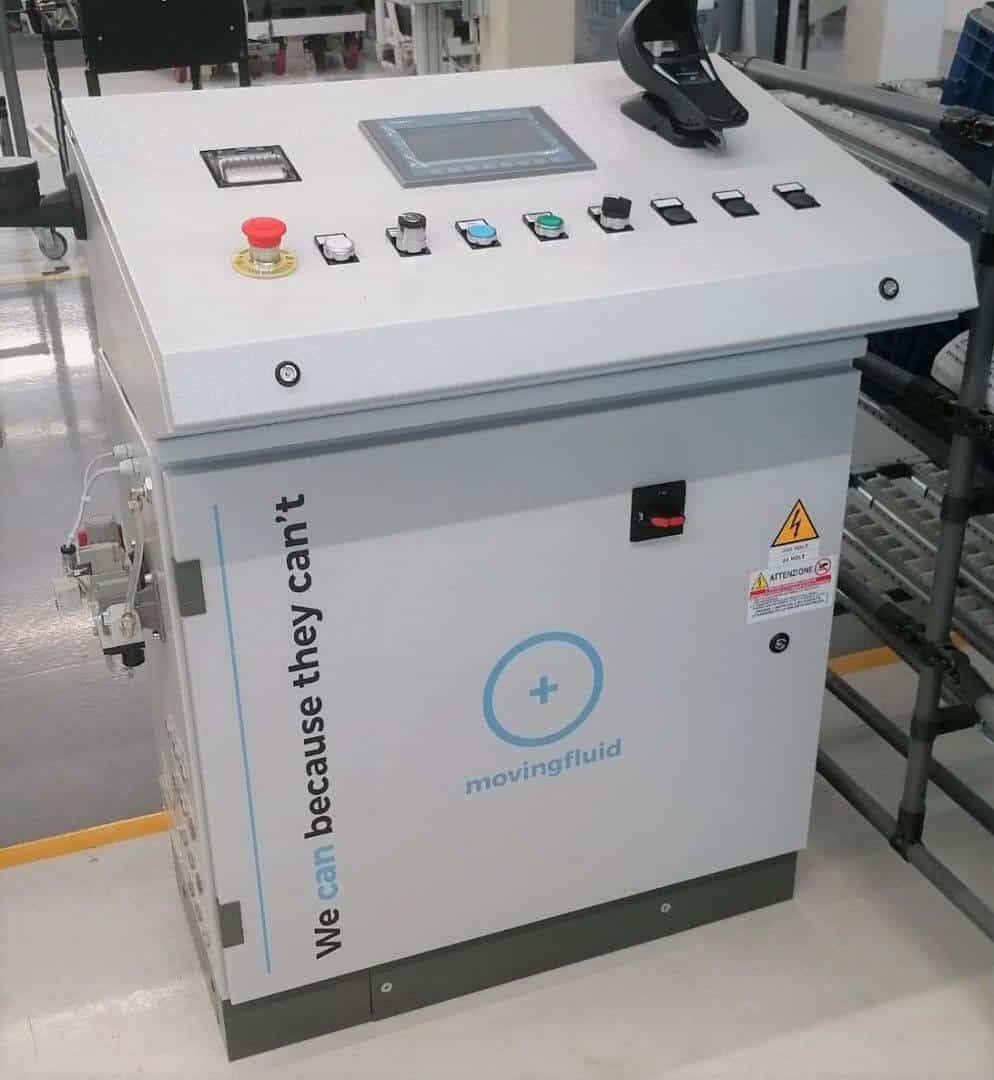
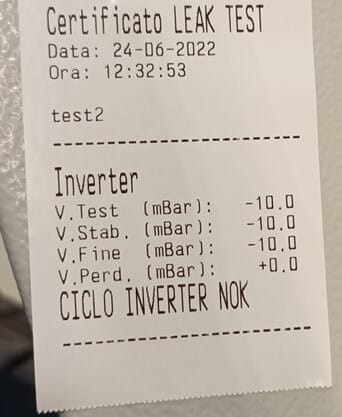
Phase 3: pre-assembly inverter testing
In order to ensure that the inverter pre-assembly phase was faultless, the following applied test was carried out:
- PILOTED LOW VACUUM inverter pre-assembly test
Test performance:
- in the affected area (only one) a vacuum was created with a 1.5 m2/hr mignon vane pump
- in view of the internal geometry of the pump used, in order to prevent the vacuum from having an unstable value, an electronic vacuum regulator set at the start of the cycle, according to specific requirements, was inserted. This system is capable of generating a PILOTED LOW VACUUM with a deviation of a tenth of a millibar
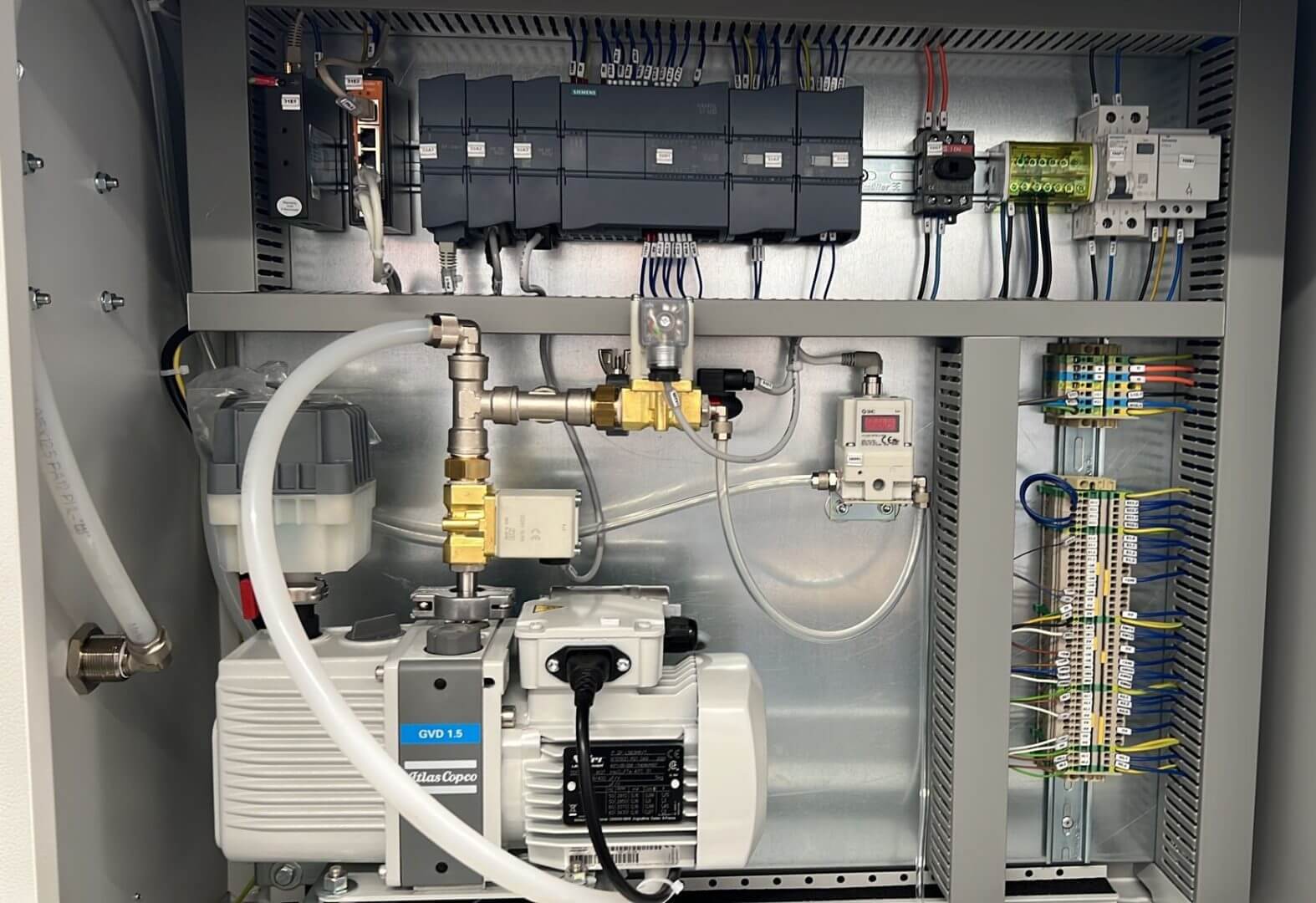
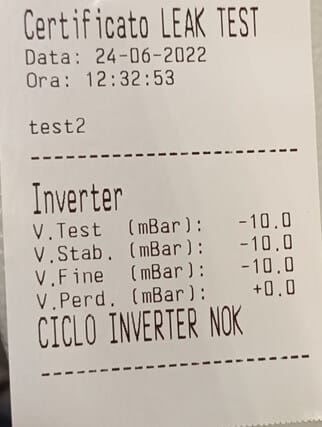
Phase 4: plate heat exchanger test
To test the plate heat exchanger for internal faults, the following checks were carried out:
- LOW-PRESSURE plate heat exchanger test
Test performance:
- the affected areas are 2, the water part and the oil part
- the 2 zones were pressurised sequentially and the following parameters were checked:
-
- whether there was a pressure drop, indicative of a defect
- whether an increase in pressure in the NON-CYLINDER HEAD zone was detectable, which is a discriminating indication to locate a possible leakage to the outside or the presence of an internal leakage
-
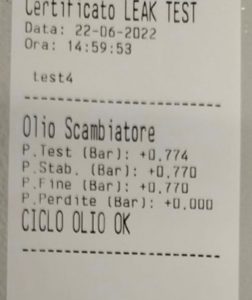
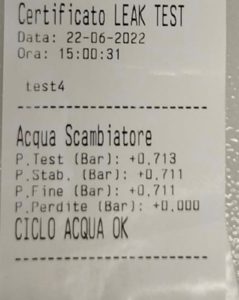
Phase 5: testing and filling circuits
After the aforementioned preliminary checks, with the positive outcome of each phase of the Leak Test, we proceeded to the final phase of the process, i.e. filling the circuit and levelling the liquid in it.
To this end, all the components assembled in the vehicle – such as circuits, trays, pumps and control units – were subjected to a final leak test, which was essential to ensure the hybrid engine’s suitability for filling.
These are the tests performed:
- HIGH VACUUM dielectric oil
- HIGH VACUUM testing and filling of the brakes oil circuit
- HIGH VACUUM testing and filling of the engine coolant circuit
- HIGH VACUUM testing and filling of the power steering oil circuit
- HIGH VACUUM testing and filling of the cabin AC and batteries
Do you want to know the details of the filling and levelling operation? You can find the full description of each step in our article presenting the new complete Leak Test system for hybrid and endothermic engines, which we invite you to read.
Everything is clear, but would you like to see the Leak Test system in operation?
Never mind being Lamborghini
Our mishap solvers have numbers
Our collaboration with Lamborghini is made up of numbers that speak for themselves. They speak of a confidence fuelled by results. And of a professional and human relationship built over time, with seriousness and respect. Approach always held by our team, assisting anyone who has the desire to make an improvement or solve a mishap that impacts the performance of their system.
To date, we have supported the well-known automotive brand in checking and filling circuits of the following conventionally powered vehicles, accompanying them all the way to the road:
- 15,000 Urus, for which we performed the testing and filling of:
-
- brake oil
- engine coolant
- air conditioning gas
- windscreen washer fluid
- air suspensions
-
- 10,000 Aventadors, for which we carried out tests and air-conditioning gas filling
- 20,000 Huracans, for which we carried out testing and filling of air conditioning gas and fuel tank Leak Tests
45,000 successful filling tests on various models with endothermic engines. Experience that our innovative Leak Test system now makes perfectly scalable in the world of hybrids, thanks to the possibility of testing extended to all electrical components.
Movingfluid is already building a future with clean energy.
If you are doing the same
- Alstom [1]
- ARO Ingersoll Rand [1]
- Automotive [8]
- Brembo [2]
- Case History [13]
- Cast iron brakes [1]
- Ceramic [2]
- Chemical [3]
- Chemistry [2]
- Cleaning [1]
- Dilution [1]
- Dosage [4]
- Dust [1]
- Extrusion [3]
- Finishing [1]
- Fluid handling [1]
- Fluids [2]
- Food [1]
- Freni in ghisa [1]
- Gases [3]
- Glue [2]
- Henkel [1]
- Industrial Painting [4]
- IVECO [1]
- Know-how [2]
- Körber Tissue [2]
- Lamborghini [2]
- Liquid paint [1]
- Liquids [6]
- LPR [1]
- Market news [4]
- Nikola [1]
- Oenology [2]
- Paint [2]
- Paper [2]
- Paper converting [1]
- Paper industry [2]
- Powder Coating [1]
- Powders [1]
- Raw material producer [1]
- Spraying [5]
- Streparava [1]
- Tissue [3]
- Tissue converting [1]
- Toscotec [1]
- Trail [1]
- Transfer [7]
- Verniciatura industriale [3]